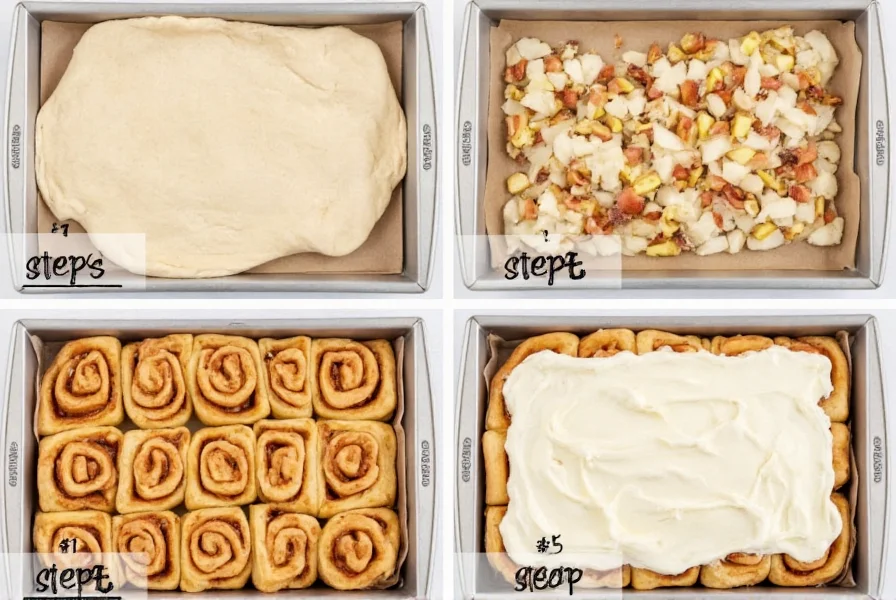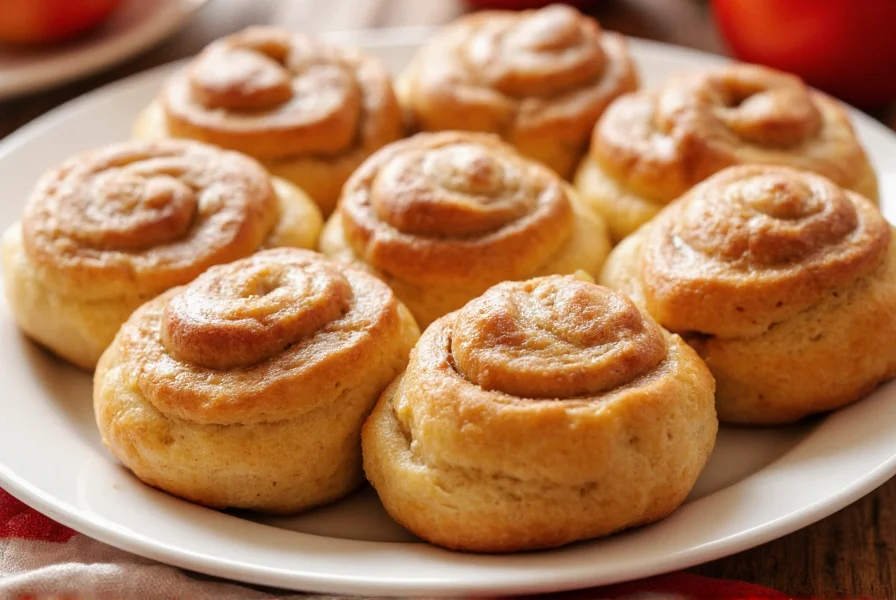There's something uniquely comforting about the aroma of baked apple cinnamon rolls filling a kitchen. These delightful pastries combine the flaky, buttery texture of traditional cinnamon rolls with the warm, fruity essence of baked apples. Unlike regular cinnamon rolls, the addition of apples creates a wonderful textural contrast and a more complex flavor profile that balances sweetness with natural tartness.
The Essential Components of Perfect Baked Apple Cinnamon Rolls
Creating exceptional baked apple cinnamon rolls requires attention to three critical elements: the dough, the apple-cinnamon filling, and the icing. Each component must be executed properly to achieve that perfect balance of flavors and textures that makes this variation superior to standard cinnamon rolls.
Ingredients for Homemade Baked Apple Cinnamon Rolls
Making homemade baked apple cinnamon rolls from scratch requires quality ingredients measured precisely. Here's what you'll need:
| Component | Ingredients | Measurements |
|---|---|---|
| Dough | All-purpose flour | 4½ cups (560g) |
| Warm whole milk | 1 cup (240ml) | |
| Active dry yeast | 2¼ tsp (7g) | |
| Granulated sugar | ⅓ cup (65g) | |
| Unsalted butter, melted | ⅓ cup (75g) | |
| Apple Filling | Granny Smith apples, peeled and diced | 2 cups (300g) |
| Brown sugar | ½ cup (100g) | |
| Cinnamon | 2 tbsp | |
| Unsalted butter, cubed | 3 tbsp (40g) | |
| Icing | Cream cheese, softened | 4 oz (115g) |
| Powdered sugar | 1½ cups (180g) | |
| Vanilla extract | 1 tsp |

Step-by-Step Preparation Guide
Follow these detailed apple cinnamon roll baking instructions for perfect results every time:
Dough Preparation
- In a small bowl, combine warm milk (110°F/43°C), yeast, and 1 teaspoon of the sugar. Let sit for 5-7 minutes until foamy.
- In a large mixing bowl or stand mixer, combine flour, remaining sugar, melted butter, and salt.
- Add the yeast mixture and one egg. Mix until a soft dough forms.
- Knead for 5-7 minutes until smooth and elastic. The dough should be slightly tacky but not sticky.
- Place in a greased bowl, cover, and let rise in a warm place for 1-1.5 hours, until doubled.
Apple Filling Preparation
While the dough rises, prepare your apple cinnamon roll filling:
- In a medium saucepan, combine diced apples, brown sugar, cinnamon, and butter.
- Cook over medium heat for 8-10 minutes, stirring occasionally, until apples are tender but still hold their shape.
- Cool completely before using. This step is crucial—warm apples will melt the dough.
Assembly and Baking
- Punch down risen dough and roll out on a floured surface into a 16x12 inch rectangle.
- Spread cooled apple mixture evenly over the dough, leaving a ½ inch border.
- Tightly roll up the dough starting from the long side.
- Cut into 12 equal pieces using dental floss or a serrated knife.
- Place rolls cut-side down in a greased 9x13 inch baking pan.
- Cover and let rise for 30-45 minutes until puffy.
- Bake at 350°F (175°C) for 25-30 minutes, until golden brown.

Professional Baking Tips for Best Results
These apple cinnamon roll dough preparation tips from professional bakers will elevate your results:
- Temperature control: Ensure your milk is precisely 110°F (43°C)—too hot will kill the yeast, too cold won't activate it properly.
- Apple selection: Granny Smith apples provide the ideal tartness and hold their shape well during baking. Avoid softer varieties like Red Delicious.
- Dough thickness: Roll your dough to an even ¼ inch thickness for consistent baking and proper rise.
- Cutting technique: Use unflavored dental floss to slice rolls cleanly without compressing the dough.
- Rising environment: Create a warm, draft-free space by placing dough in the oven with just the light on.
Troubleshooting Common Baking Issues
Address these frequent apple cinnamon roll baking problems with these solutions:
- Dense rolls: Usually caused by too much flour or under-proofed dough. Measure flour by weight for accuracy and ensure proper rising time.
- Soggy bottom: Results from wet apple filling. Always cool filling completely and consider adding 1 tbsp cornstarch to the apple mixture.
- Rolls spreading sideways: Indicates over-proofing. Watch carefully during the second rise—rolls should be puffy but still hold their shape.
- Burnt edges: Cover loosely with foil during the last 10 minutes of baking if edges are browning too quickly.
Serving and Storage Recommendations
For the best apple cinnamon roll experience, follow these guidelines:
- Serve warm, ideally within 2 hours of baking, when the texture is at its peak.
- Apply icing while rolls are still warm (but not hot) so it melts slightly into the crevices.
- Store leftovers in an airtight container at room temperature for up to 2 days.
- For longer storage, freeze baked rolls (without icing) for up to 3 months. Thaw and reheat before icing.
- Reheat in a 300°F (150°C) oven for 10-15 minutes to restore freshness—avoid microwaving which makes them rubbery.
Delicious Variations to Try
Once you've mastered the classic baked apple cinnamon rolls recipe, experiment with these creative twists:
- Nutty version: Add ½ cup chopped pecans or walnuts to the apple filling for extra crunch.
- Caramel apple: Drizzle 2 tbsp caramel sauce into the apple filling mixture.
- Spiced apple: Enhance the cinnamon with ½ tsp each of nutmeg and allspice.
- Gluten-free option: Use a quality gluten-free flour blend and add 1 tsp xanthan gum to the dough.
- Vegan adaptation: Substitute plant-based milk, vegan butter, and an egg replacer for a dairy-free version.
Frequently Asked Questions
Can I prepare baked apple cinnamon rolls ahead of time?
Yes, you can prepare baked apple cinnamon rolls through the assembly stage, then cover and refrigerate overnight. Remove from the refrigerator 1-2 hours before baking to allow proper rising. Alternatively, bake them completely, then freeze for up to 3 months. Reheat from frozen when needed.
Why are my apple cinnamon rolls too dense?
Dense apple cinnamon rolls typically result from too much flour in the dough, under-proofed dough, or old yeast. Measure flour by weight for accuracy (560g for this recipe), ensure your yeast is fresh and properly activated, and allow sufficient rising time until the dough has doubled in size.
What's the best apple variety for cinnamon rolls?
Granny Smith apples are ideal for baked apple cinnamon rolls because they maintain their shape during baking and provide the perfect tart contrast to the sweet dough. Honeycrisp or Braeburn apples also work well as secondary options, but avoid softer varieties like Red Delicious which become too mushy.
How do I prevent my apple filling from making the rolls soggy?
To prevent soggy apple cinnamon rolls, always cool your apple filling completely before assembling. You can also toss the cooked apples with 1 tablespoon of cornstarch before spreading on the dough, which absorbs excess moisture. Another tip is to drain any liquid from the cooked apples before using them in your filling.
Can I make baked apple cinnamon rolls without yeast?
While traditional baked apple cinnamon rolls use yeast for that characteristic fluffy texture, you can make a quick bread version using baking powder instead. However, the texture and flavor profile will be significantly different—more like a sweet coffee cake than a classic cinnamon roll. For authentic results, yeast is essential to achieve the proper texture and flavor development.











 浙公网安备
33010002000092号
浙公网安备
33010002000092号 浙B2-20120091-4
浙B2-20120091-4